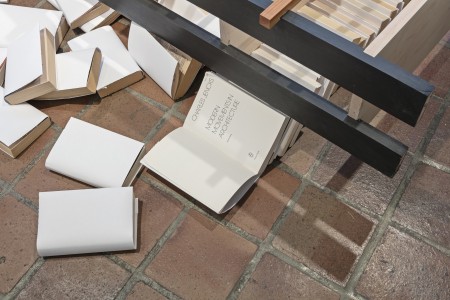20 October to 26 November 2016

Central to Derek Sullivan’s practice is the question that exists between what a book is and what it can be. The paradox of books is that while they are both literally and figuratively heavy they are also malleable, flexible. Their meaning shifts over time to perform a variety of roles whether emotional, intellectual, or professional. Like tools, they are able to both find and possess functions outside the objectives of author, designer, printer, binder, publisher, distributor, seller, reviewer, and reader.
On Filling In extends this inquiry into the environments that books occupy—namely, a library—with a site-specific installation. A library’s ontology is defined not just by what it contains, but what it is missing. This is doubly so for a library under pressure. A library that, as poet Craig Dworkin describes, “is print in its gaseous state filling every available space”. A gallery’s library for example. A library that bears the professional weight of authority and legitimacy, accumulated over a generation. What happens when such a library is displaced? What kind of anxiety awaits us with the peculiar emptiness of shelves? Books tie us to place. When packed in boxes, ready to ship or store, it is too easy to feel untethered from the world. Printed matter weighs us down, necessarily. Perhaps this is the phenomenon that books offer us in an ever-increasing digitized, de-materialized environment. A world in flux. Or maybe, they simply provide an aspirational space in which the leisure to read for pleasure or the patience required to acquire knowledge is possible.
Sullivan’s recent drawings form an index of time spent reading, looking, and considering. Their subject matter slowly emerged through an act of accumulation. Like a library, each drawing describes a collection of sorts. Composed of eight smaller drawings, they depict an early stage in book production called a signature – where groups of pages are printed on both sides of a single sheet of paper. The completely de-familiarized shape of a signature serves to emphasize circumstance over content. Are we looking at books complete or fragments of larger volumes? Either way, we are left to fill in, to close the gap of understanding that Sullivan initiates.

